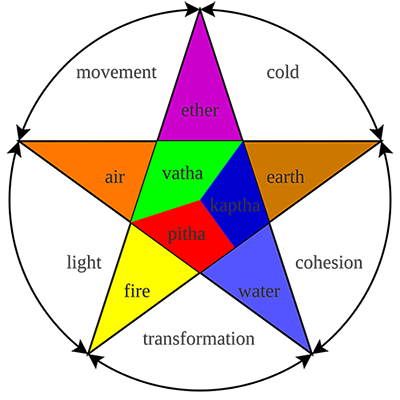Ayurveda was derived from Artharva Veda and Vedic era is considered to be the time, when Ayurveda flourished as a science. It is estimated that around 1000 B.C., two major texts Samhita of Ayurveda, Charaka Samhita and Sushruta Samhita was composed. Charaka Samhita deals with medicine and Sushruta Samhita deals with surgery. Distinguished scholars were attracted to the science of Ayurveda and visited India for acquiring scientific language.

Ayurveda is based on peculiar fundamental principles like Tridosha (three humors Vata, pitta, and kapha) theory, and Panchamahabhuta (five elements ether, air, fire, water and earth) theory. Imbalance of the three humors is considered to be the root cause of the disease.
- Vata is a combination of air and ether,
- Pitta is a combination of earth and fire.
- Kapha is a combination of ether and water.
Further five subtypes of vata; pitta and kapha have been described in Ayurveda. These are enumerated below:
Five Types of Vata
- Prana Vayu: The main function of Prana Vayu is swallowing, Breathing and blood circulation,
- Udana Vayu: The main function of Udana Vayu is memory, speech, and sound,
- Vyana Vayu: The main function of Vyana Vayu is blinking, perspiration and other movements.
- Samana Vayu: The main function of Samana Vayu is digestion of food-stuffs and formation of waste products,
- Apana Vayu: The main function of Apana Vayu is Excretion of the excreta including urine and stools (waste products).
Five Types of Pitta
- Ranjaka Pitta: The main function of Ranjaka pitta is to impart color to the blood, bile, and feces,
- Sadhaka Pitta: The main function of Sadhaka Pitta is dealing with memory and intellect,
- Alochaka Pitta: The main function of Alochaka pitta is concerned with visual perception,
- Bharajaka Pitta: The main function of Bharajaka pitta is concerned with the coloration of the skin,
- Pachaka Pitta: The main function of Pachaka pitta is concerned with digestion of foods.
Five Types of Kapha
- Tarpaka Kapha: The main function of Tarpaka Kapha is concerned with hearing and sensory perception,
- Avalambaka Kapha: The main function of Avalambaka Kapha is concerned with protection the lungs and the heart,
- Kledaka Kapha: The main function of Kledaka Kapha is concerned with the process the digestion of foods,
- Bodhaka Kapha: The main function of Bodhaka Kapha is concerned with gustatory perception,
- Sleshaka Kapha: The main function of Sleshaka Kapha deals with the lubrication of the joints.
The aim of the treatment is in correcting the imbalance of the biological humor. The great seers of Ayurveda developed peculiar methods for testing the potency of the drugs. If the literature is consulted, it can be concluded that drugs like Harada, Arjuna, Atibala, and Shilajeet seem to be thoroughly investigated for their medicinal activities.
The diagnosis of the disease is largely based on pulse examination. An expert Ayurvedic doctor is in a position to tell about the disease process by examining the pulse.
Detailed Investigation Includes:-
- Interrogation of the patient in terms of body constitution, exercising and digestive capacity, Objective examination to assess the progress of the disease,
- Examination by inference like color of skin, urine, and state of the pupil,
Ayurvedic pharmacy is a vast subject. Dravyaguna deals with the study of drugs derived from nature and Rasa-Shastra deals with the study of minerals.
Drug Formulation in Ayurveda is based on Following Seven Parameters:
- Dravya (Substance)
- Rasa (Taste)
- Guna (Property)
- Virya (Potency)
- Vipaka (Post digestion effect)
- Prabha (Therapeutics)
- Karma (Pharmacological activity)
Dravya is described as a substance used for medicinal purpose. According to Ayurvedic principles, every component of the universe is dravya and is of medicinal value. Drugs derived from herbs, minerals and animal source, all are included in dravya. Charaka Samhita has described dravya to be the nucleus of Ayurvedic pharmacy.
The diagnosis of a disease is based on the imbalance of the three biological humours (Vata, Pitta, and Kapha) and treatment is based on six tastes (sweet, sour, salt, pungent, bitter and astringent).
Property (guna) parameter is a vast topic. Ayurveda described forty-one properties, comparable to the physical properties of the drugs.
Virya (potency) is described as an active constituent of the drug. Virya (potency) is responsible for the pharmacological activity of the medicinal herb. The drugs have cold and hot potencies.
Vipaka and prabhava are comparable with biotransformation and therapeutic activity of the drug.
Karma describes the pharmacological activity of the drug.
